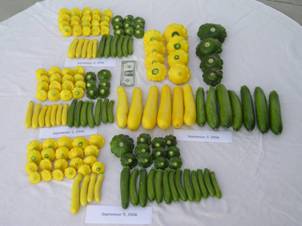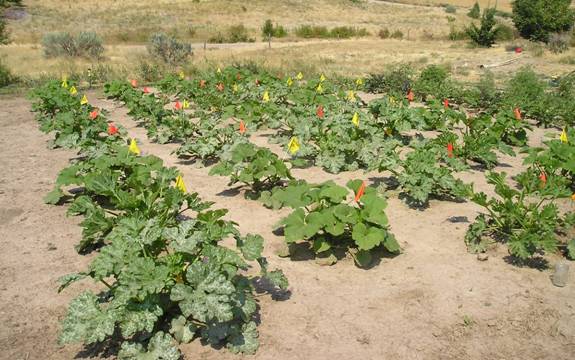![]()
Pollinator Paradise Leafcutting
bees & alfalfa The
Solitary Bee Web
Binderboard™
New Mexico Native Bee Pollinator Project Nampa
Farmer's Market About Dr. Strickler
Bee Nests and Accessories
Links to Food, Gardening and Nutrition Information
Recipes
Pollination Moments
Summer Squash Research Summer Squash Diary Blog
![]()
This project was funded by a Farmer / Rancher grant from the Western Sustainable Agriculture Research and Education Program, Project Number, FW06-042 |
|
Harvest Frequency, Yield, and Economics of Summer Squash |
|
|
Final Report, February, 2008 |
|
|
|
Table of ContentsSummary Download a pdf
of this report. Follow the
growth of my
summer squash patch and market garden: |

Squash harvest over a 3 day period. |
SummaryDuring the 2006 growing season in the Treasure Valley of Southwest Idaho I harvested four summer squash varieties either daily at a small size, or every 2-3 days at a larger size. Squash harvested at the larger size yielded about 3 times more by weight than squash harvested when small, but the plants produced 2-3 times as many squash fruits when I harvested more frequently at a small size. Both squash sizes sold well at the Nampa & Caldwell, Idaho Farmers’ Markets, with less small squash than large squash left unsold at the end of market day most weeks. Large patty pan squash were the least popular. Customers preferred to buy squash by numbers rather than weight, even though they paid a premium price: Small squash when sold at 5-8 for $1 brought in up to $2.97 per pound and were more profitable than large squash. Bottom line: the extra effort to grow baby squash was justified. This study suggests that squash growers on small acreage should consider increased production of baby summer squash. Tasting and sale of grilled squash at farmers’ markets can also be considered to increase profits. |
ObjectivesThe goal of this study was to determine how harvest frequency and harvest size affect the yield and marketability of fruits produced by summer squash plants, Cucurbita pepo. In particular, I compared the yields from harvesting squash daily at a small size for mini squash vs. every 2-3 days at a larger size. I wondered if harvesting mini squash is worth the extra effort, and if it can be profitable for a small market gardener. Therefore the study also included a customer survey at two Farmers’ Markets, a vendor survey and development of an enterprise budget for squash production aimed at market gardeners and small farmers. |
|
|
This squash experiment got off to a late start in summer 2006 because of a family emergency in June, but I was able to accomplish much of what I set out to do. I used four summer squash varieties: two zucchini (green: Cash Flow from Johnny’s Selected Seeds, yellow: Butterstick from Territorial Seed Company) and two patty pans (green: Starship from Territorial Seed Company and yellow: Sunburst from Territorial Seed Company). A total of 40 equally spaced hills were created in a sprinkler irrigated (K2 Smart Set gear drive sprinkler heads) garden plot. Two gallons of commercial composted steer manure were added to each hill before planting. The hills were randomly assigned a variety and harvest frequency so that there were 5 hills of each variety and harvest frequency combination. I planted an extra hill of each variety in case some hills were damaged or aberrant. |
Methods and Materials
|
|
I labeled brown paper shopping bags with the hill number, variety, and harvest frequency of each hill, and used the bags to harvest the squash throughout the season. The squash were weighed individually after harvest each day. I obtained temperature and degree day (base 50°F) data for the UI Parma Research and Extension Center (about 3 miles from my squash plot) from the Agrimet (U.S. Dept. of Interior The Pacific Northwest Cooperative Agricultural Weather Network) web site. |
 August 8, flowering begins. Flags indicate harvest frequency. Note that the leaves of zucchini varieties (e.g., bottom left and bottom right) were more deeply divided than were the leaves patty pan varieties (e.g., bottom center). This photo was taken from the same vantage point as the figure above. |
![]()
![]()
Copyright © December 21, 2007, Karen Strickler. All rights reserved.